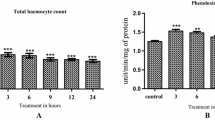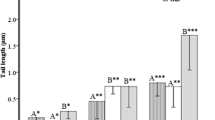Abstract
Entomopathogenic nematodes (EPNs) of the genera Steinernema and Heterorhabditis are lethal parasites of many insect species. To investigate defensive mechanisms towards EPNs in relation to antioxidative and detoxifying enzymes, we chose Tenebrio molitor (Coleoptera: Tenebrionidae) as experimental insect. We studied the activity changes of superoxide dismutases (SODs), peroxidases (PODs), and catalases (CATs), as well as tyrosinase (TYR), acetylcholinesterase (AChE), carboxylesterase (CarE), and glutathione S-transferase (GSTs) for 40 h in T. molitor larvae infected with Heterorhabditis beicherriana infective juveniles (IJs) at 5 rates (0, 20, 40, 80, and 160 IJs/larva). We found that when T. molitor larvae infected with H. beicherriana at higher rates (80 and 160 IJs/larva), SOD activity quickly increased to more than 70 % higher than that control levels. The activities of POD and CAT increased after 24 h. TYR activity increased slowly at lower rates of infection for 16 h, followed by a slight decrease, and then increasing from 32 to 40 h. The other detoxifying enzymes (GST, CarE, and AChE) were enhanced at lower infection rates, but were inhibited at higher rates. Our results suggested that host antioxidative response and detoxification reactions played a central role in the defensive reaction to EPNs, and that this stress which was reflected by the higher level enzymes activity contributed to the death of hosts. Further study should explore the exact function of these enzymes using different species of EPNs and investigate the links between enzyme activity and host susceptibility to EPNs.




Similar content being viewed by others
References
Ahmad S (1992) Biochemical defense of pro-oxidant plant allelochemicals by herbivorous insects. Biochem. Syst Ecol 20:269–296. doi:10.1016/0305-1978(92)90040-K
Balasubramanian N, Toubarro D, Simões N (2010) Biochemical study and in vitro insect immune suppression by a trypsin-like secreted protease from the nematode Steinernema carpocapsae. Parasite Immunol 32:165–175. doi:10.1111/j.1365-3024.2009.01172.x
Bradford MM (1976) A rapid and sensitive method for the quantitation of microgram quantities of protein utilizing the principle of protein-dye binding. Anal Biochem 72:248–254. doi:10.1006/abio.1976.9999
Clark AG (1990) The glutathione S-transferases and resistance to insecticides. In: Hayes JD, Pickett CB, Mantle TJ (eds) Glutathione S-transferases and drug resistance. Taylor and Francis, London, pp 369–378
Costa JCR, Dias RJP, Morenz MJF (2007) Determining the adaptation potential of entomopathogenic nematode multiplication of Heterorhabditis riobravus and Steinernema carpocapsae (Rhabditida: Heterorhabditidae, Steinernematidae) in larvae of Alphitobius diaperinus (Coleoptera: Tenebrionidae) and Galleria mellonella (Lepidoptera: Pyralidae). Parasitol Res 102:139–144. doi:10.1007/s00436-007-0747-9
da Silva OS, Prado GR, da Silva JLR, Silva CE, da Costa M, Heermann R (2013) Oral toxicity of Photorhabdus luminescens and Xenorhabdus nematophila (Enterobacteriaceae) against Aedes aegypti (Diptera: Culicidae). Parasitol Res 112:2891–2896. doi:10.1007/s00436-013-3460-x
Eleftherianos I, Boundy S, Joyce SA, Aslam S, Marshallet JW et al (2007) An antibiotic produced by an insect-pathogenic bacterium suppresses host defenses through phenoloxidase inhibition. Proc Natl Acad Sci U S A 104:2419–2424. doi:10.1073/pnas.0610525104
Ellman GL, Courtney KD, Andres VJ, Featherstone RM (1961) A new and rapid colorimetric determination of acetylcholinesterase activity. Biochem Pharmacol 7:88–95. doi:10.1016/0006-2952(61)90145-9
Felton GW, Summers CB (1995) Antioxidant Systems in Insects. Arch Insect Biochem 29:187–197. doi:10.1002/arch.940290208
Felton GW (1995) Antioxidant defenses of vertebrates and invertebrates. In: Ahmad S(ed) Oxidative Stress and Antioxidant Defenses in Biology. Chapman and Hall, New York, pp 356–434
Fournier D (2005) Mutations of acetylcholinesterase which confer insecticide resistance in insect populations. Chem Biol Interact 157–158:257–261. doi:10.1016/j.cbi.2005.10.040
Gay PA, Tuzun S (2000) Temporal and spatial assessment of defense responses in resistant and susceptible cabbage varieties during infection with Xanthomonas campestris pv. Campestris. Physiol Mol Plant P 57:201–210. doi:10.1006/pmpp.2000.0299
Grewal P, Ehlers RU, Shapiro-llan DI (2005) Nematodes as biological control agents. CABI Publishing, Wallingford
Habig WH, Pabst MJ, Jakoby WB (1974) Glutathione S-transferase. The first enzymatic step in mercapturic acid formation. J Biol Chem 249:7130–7139
Hao YJ, Montiel R, Nascimento G, Toubarro D, Simoes N (2008) Identification, characterization of functional candidate genes for host–parasite interactions in entomopathogenetic nematode Steinernema carpocapsae by suppressive subtractive hybridization. Parasitol Res 103:671–683. doi:10.1007/s00436-008-1030-4
Havir EA, McHale NA (1987) Biochemical and developmental characterization of multiple forms of catalase in tobacco leaves. Plant Physiol 84:450–455. doi:10.1104/pp.84.2.450
Herath PRJ, Hemingway J, Weerasinghe IS, Jayawardena KGI (1987) The detection and characterization of malathion resistance in field populations of Anopheles culicifacies B in Sri Lanka. Pestic Biochem Phys 29:157–162. doi:10.1016/0048-3575(87)90074-5
Hoffmann JA, Reichhart JM, Hetru C (1996) Innate immunity in higher insects. Curr Opin Immunol 8:8–13. doi:10.1016/S0952-7915(96)80098-7
Jamieson D (1989) Oxygen toxicity and reactive oxygen metabolites in mammals. Free Radic Biol Med 7:87–108. doi:10.1016/0891-5849(89)90103-2
Jarosz J, Balcerzak M, Skrzypek H (1991) Involvement of larvicidal toxins in pathogenesis of insect parasitism with the rhabditoid nematodes, Steinernema feltiae and Heterorhabditis bacteriophora. Entomophaga 36:361–368. doi:10.1007/BF02377940
Kehrer JP, Smith CV (1994) Free radicals in biology: sources, reactivities, and roles in the etiology of human diseases. In: Frei B (ed) Natural antioxidants in human health and disease. Academic, New York, pp 25–62
Li X, Liu Q, Nermut J, Puza V, Mracek Z (2012) Heterorhabditis beicherriana n. sp. (Nematoda: Heterorhabditidae), a new entomopathogenic nematode from from the Shunyi district of Beijing, China. Zootaxa 3569:25–40
Liu HX, Jiang WB, Bi Y, Luo YB (2005) Postharvest BTH treatment induces resistance of peach (Prunus persica L. cv. Jiubao) fruit to infection by Penicillium expansum and enhances activity of fruit defense mechanisms. Postharvest Biol Tec 35:263–269. doi:10.1016/j.postharvbio.2004.08.006
Maxwell PW, Chen G, Webster JM, Dunphy GB (1994) Stability and activities of antibiotics produced during infection of the insect Galleria mellonella by two isolates of Xenorhabdus nematophilus. Appl Environ Microbiol 60:715–721
Mbata GN, Shapiro-llan DI (2005) Laboratory evaluation of virulence of heterorhabditid nematodes to Plodia interpunctella Hübner (Lepidoptera: Pyralidae). Environ Entomol 34: 676-682. doi: http://dx.doi.org/10.1603/0046-225X-34.3.676
Moret Y, Siva-Jothy MT (2003) Adaptive innate immunity? Responsive-mode prophylaxis in the mealworm beetle, Tenebrio molitor. Proc R Soc Lond B 270:2475–2480. doi:10.1098/rspb.2003.2511
Moret Y (2006) ‘Trans-generational immune priming’: specific enhancement of the antimicrobial immune response in the mealworm beetle, Tenebrio molitor. Proc Biol Sci 273:1399–1405. doi:10.1098/rspb.2006.3465
Mracek Z, Webster JM (1993) Survey of Heterorhabditidae and Steinernematidae (Rhabditida: Nematoda) in Western Canada. J Nematol 25:710–717
Muñoz P, Mesegue J, Esteban MA (2006) Phenoloxidase activity in three commercial bivalve species. Changes due to natural infestation with Perkinsus atlanticus. Fish Shellfish Immun 20:12–19. doi:10.1016/j.fsi.2005.02.002
Paes MC, Oliveira MB, Oliveira P (2001) Hydrogen peroxide detoxification in the midgut of the blood-sucking insect, Rhodnius prolixus. Arch Insect Biochem 48:63–71. doi:10.1002/arch.1058
Rahman I, Macnee W (2000) Regulation of redox glutathione levels and gene transcription in lung inflammation: therapeutic approaches. Free Radic Bio Med 28:1405–1420. doi:10.1016/S0891-5849(00)00215-X
Ratcliffe NA, Rowley AF, Fitzgerald SW, Rhodes CP (1985) Invertebrate immunity: basic concepts and recent advances. Int Rev Cytol 97:183–350
Schenk PM, Kazan K, Wilson I, Anderson JP, Richmond T, Somerville SC, Manners JM (2000) Coordinated plant defense responses in Arabidopsis revealed by microarray analysis. Proc Natl Acad Sci U S A 97:11655–11660. doi:10.1073/pnas.97.21.11655
Seo S, Lee S, Hong Y, Kim Y (2012) Phospholipase A2 inhibitors synthesized by two entomopathogenic bacteria, Xenorhabdus nematophila and Photorhabdus temperate subsp. temperate. Appl Environ Microbiol 78:3816–3823. doi:10.1128/AEM.00301-12
Sheehan D, Meade G, Foley VM, Dowd CA (2001) Structure, function and evolution of glutathione transferases: implications for classification of non-mammalian members of an ancient enzyme superfamily. Biochem J 360:1–16. doi:10.1042/0264-6021:3600001
Simoäes N, Rosa JS (1996) Pathogenicity and host specificity of entomopathogenic nematodes. Biocontrol Sci Techn 6:403–411. doi:10.1080/09583159631370
Soreq H, Seidman S (2001) Acetylcholinesterase - new roles for an old actor. Nat Rev Neurosci 2: 294-302. doi:10.1038/35067589
Söderhäll K, Cerenius L (1998) Role of the prophenoloxidase-activating system in invertebrate immunity. Curr Opin Immunol 10:23–28. doi:10.1016/S0952-7915(98)80026-5
Sugumaran M, Nellaiappan K (2000) Characterization of a new phenoloxidase inhibitor from the cuticle of Manduca sexta. Biochem Biophys Res Commun 268:379–383. doi:10.1006/bbrc.2000.2138
Sugumaran M, Nellaiappan K, Valivittan K (2000) A new mechanism for the control of phenoloxidase activity: inhibition and complex formation with quinone isomerase. Arch Biochem Biophys 379:252–260. doi:10.1006/abbi.2000.1884
Sugumaran M (2002) Comparative biochemistry of eumelanogenesis and the protective roles of phenoloxidase and melanin in insects. Pigment Cell Res 15:2–9. doi:10.1034/j.1600-0749.2002.00056.x
Toubarroa D, Lucena-Roblesa M, Nascimentoa G, Costab G, Montiela R, Coelhob AV, Simõesa N (2009) An apoptosis-inducing serine protease secreted by the entomopathogenic nematode Steinernema carpocapsae. Int J Parasitol 39:1319–1330. doi:10.1016/j.ijpara.2009.04.013
Turrens JF (1997) Superoxide production by the mitochondrial respiratory chain. Biosci Rep 17:3–8. doi:10.1023/A:1027374931887
Ullah I, Khan AL, Ali L, Khan AR, Waqaset M, Lee I, Shin J (2014) An insecticidal compound produced by an insect-pathogenic bacterium suppresses host defenses through phenoloxidase inhibition. Molecules 19:20913–20928. doi:10.3390/molecules191220913
van Asperen K (1962) A study of housefly esterases by means of a sensitive colorimetric method. J Insect Physiol 8:401–416. doi:10.1016/0022-1910(62)90074-4
Wang Y, Oberley LW, Murhammer DW (2001) Antioxidant defense systems of two lipidopteran insect cell lines. Free Radical Bio Med 30:1254–1262. doi:10.1016/S0891-5849(01)00520-2
Wu H, Liu Q (2012) Antioxidative responses in Galleria mellonella larvae infected with the entomopathogenic nematode Heterorhabditis sp. beicherriana. Biocontrol Sci Techn 22:601–606. doi:10.1080/09583157.2012.670803
Wu H, Liu Q, Li X, Wang Y, Zhang H (2013) Activities of four enzymes in Galleria mellonella larvae infected with entomopathogenic nematode Heterorhabditis beicherriana n. sp. Afr J Agr Res 8:3245–3250
Zhang B, Helen HS, Wang J, Liu H (2011) Performance and enzyme activity of beet armyworm Spodoptera exigua (Hübner) (Lepidoptera: Noctuidae) under various nutritional conditions. Agr Sci China 10:737–746. doi:10.1016/S1671-2927(11)60057-6
Acknowledgments
This research was funded by the China National Key Technology R & D Program (No. 2014BAD16B07), China National Key Technology R & D Program (No. 2014BAD23B01), and Special Fund for Agro-scientific Research in the Public Interest (No. 201503127).
Author information
Authors and Affiliations
Corresponding author
Additional information
This paper was presented in part at the 89th Annual Meeting of ASP (American Society of Parasitologists) 24–27 July 2014, New Orleans, USA (The activity changes of four detoxifying enzymes in Tenebrio molitor larvae infected by entomopathogenic nematode Heterorhabditis beicherriana).
Research highlights
1. We study the activity changes of superoxide dismutases (SODs), peroxidases (PODs), and catalases (CATs), as well as tyrosinase (TYR), acetylcholinesterase (AChE), carboxylesterase (CarE), and glutathione S-transferase (GSTs) for 40 h in Tenebrio molitor larvae infected with Heterorhabditis beicherriana.
2. We first give the report on the resistant mechanism of T. molitor infected by EPNs in relation to activity changes of these antioxidative and detoxifying enzymes.
3. We provide the foundation for the potential role of the antioxidative-related enzymes and detoxifying enzymes on the evaluation of EPNs’ infection ability.
Rights and permissions
About this article
Cite this article
Li, X., Liu, Q., Lewis, E.E. et al. Activity changes of antioxidant and detoxifying enzymes in Tenebrio molitor (Coleoptera: Tenebrionidae) larvae infected by the entomopathogenic nematode Heterorhabditis beicherriana (Rhabditida: Heterorhabditidae). Parasitol Res 115, 4485–4494 (2016). https://doi.org/10.1007/s00436-016-5235-7
Received:
Accepted:
Published:
Issue Date:
DOI: https://doi.org/10.1007/s00436-016-5235-7




